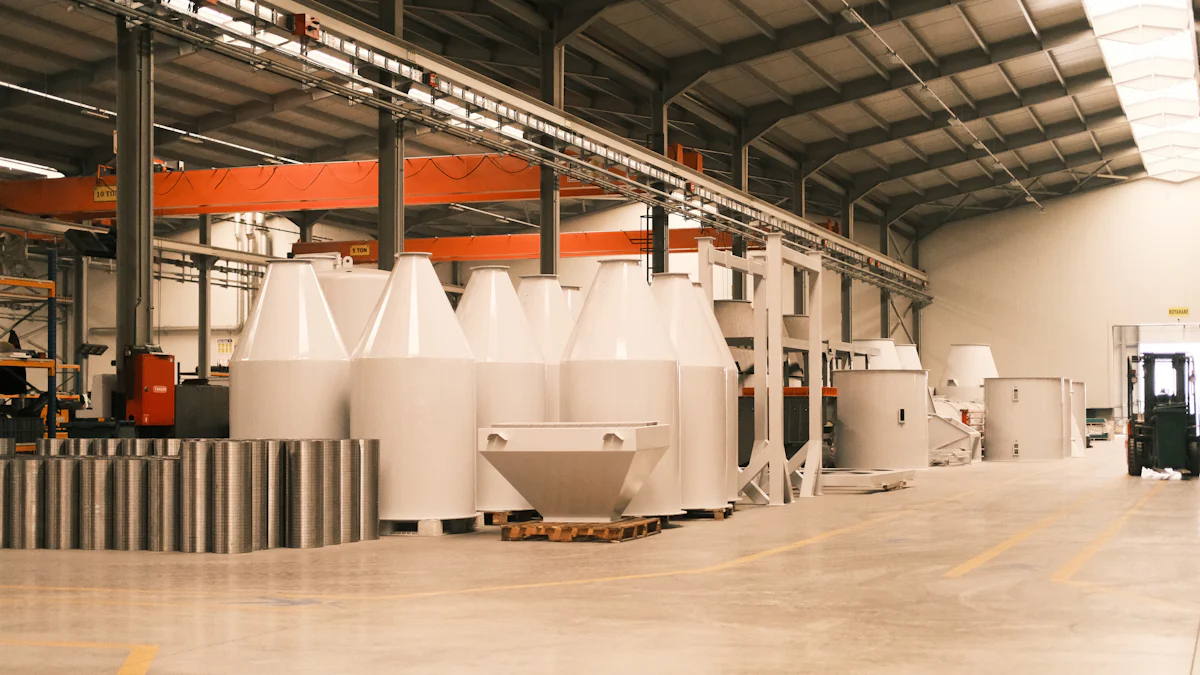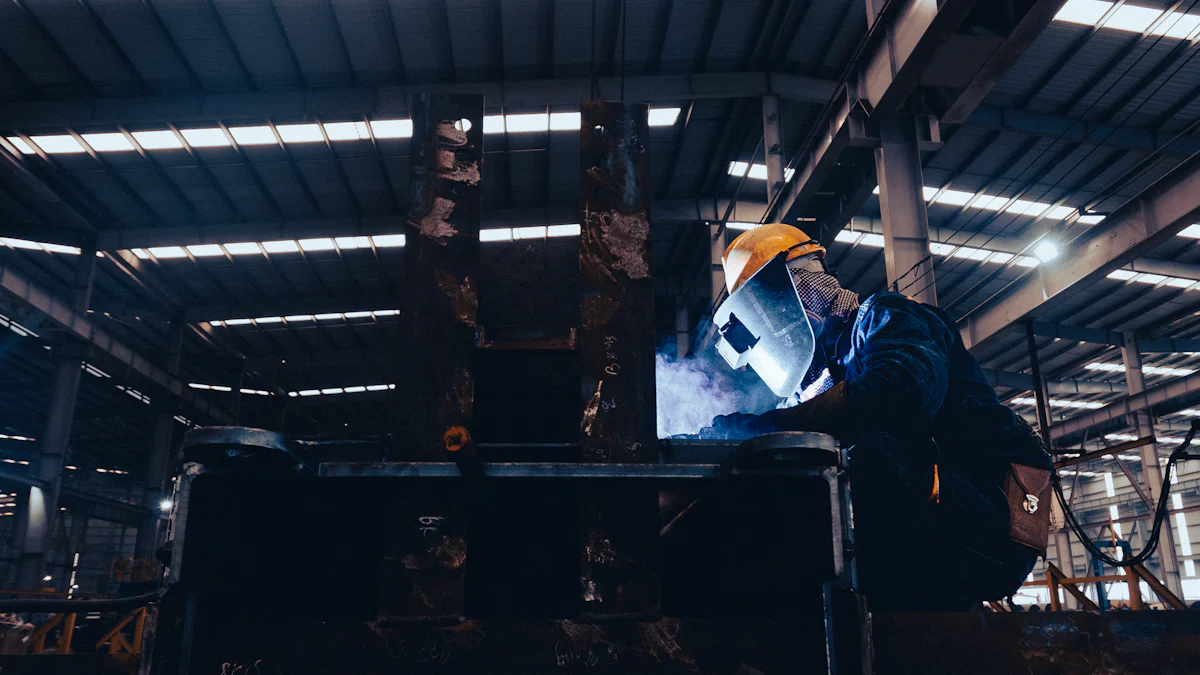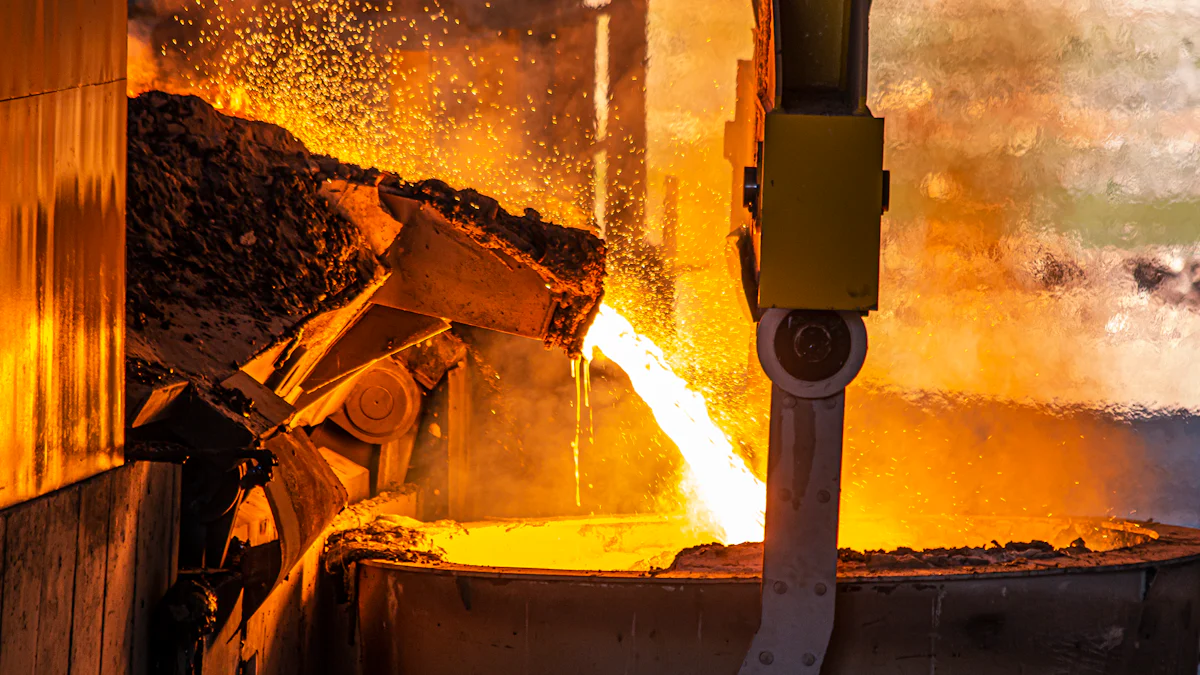
Metal Injection Molding Powder plays a pivotal role in modern manufacturing. I see it as a blend of fine metal powders and binders, creating a feedstock for shaping intricate parts. This powder is essential in the Metal Injection Molding (MIM) process, which combines precision with cost-efficiency. The global market for MIM is booming, expected to grow from 4.2billionin2023to9.1 billion by 2032. This growth highlights the increasing demand for lightweight, high-integrity components, especially in sectors like automotive and medical devices.
Key Takeaways
- Metal Injection Molding (MIM) combines fine metal powders with binders, enabling the production of complex, high-strength components efficiently.
- The global MIM market is rapidly growing, highlighting the increasing demand for lightweight and durable parts in industries like automotive and medical devices.
- Choosing the right Metal Injection Molding Powder is crucial; factors like particle size and material composition directly affect the quality and performance of the final product.
- MIM excels in creating intricate geometries without the need for secondary operations, significantly reducing production time and costs.
- This manufacturing method minimizes material waste, making it a cost-effective and sustainable choice for high-volume production.
- Industries such as aerospace, automotive, and electronics benefit greatly from MIM’s ability to produce high-precision components with excellent surface finishes.
- By leveraging the versatility of MIM, manufacturers can customize properties of the final products to meet specific application requirements.
Understanding Metal Injection Molding
The Process of Metal Injection Molding
Metal Injection Molding (MIM) fascinates me with its intricate process. It begins with mixing and molding, where I combine fine metal powders with binders to form a homogeneous feedstock. This mixture allows for precise shaping into complex geometries. The feedstock then undergoes injection molding, similar to plastic molding, to create the desired part shape.
Mixing and Molding
In the mixing stage, I meticulously blend Metal Injection Molding Powder with thermoplastic binders. This step ensures uniform distribution of metal particles, crucial for achieving consistent part quality. The resulting feedstock is then injected into molds under high pressure, forming intricate shapes that would be challenging to achieve through traditional methods.
Debinding and Sintering
After molding, I focus on debinding and sintering. Debinding removes the binder material, leaving behind a fragile “green” part. This step requires precision to avoid defects. Sintering follows, where I heat the part to a temperature below the melting point of the metal. This process fuses the metal particles, enhancing the part’s strength and density. The result is a solid, high-integrity component ready for use.
Role of Metal Injection Molding Powder
Metal Injection Molding Powder plays a pivotal role in the MIM process. Its characteristics directly influence the quality and performance of the final product.
Importance in the Process
I consider Metal Injection Molding Powder essential for achieving the desired properties in MIM parts. The powder’s particle size and distribution affect the flowability of the feedstock, impacting the molding process’s efficiency. A well-formulated powder ensures smooth injection and reduces the risk of defects.
Impact on Final Product Quality
The quality of Metal Injection Molding Powder significantly impacts the final product. Fine powders enable the production of parts with superior surface finish and dimensional accuracy. They also contribute to the mechanical properties of the component, ensuring it meets the required standards for strength and durability. By selecting the right powder, I can tailor the MIM process to produce high-quality parts for various applications.
Types of Metal Injection Molding Powders

Understanding the types of powders used in Metal Injection Molding (MIM) is crucial for optimizing the manufacturing process. Each type of powder offers unique properties that influence the final product’s quality and performance.
Common Metal Powders Used
In my experience, selecting the right metal powder is vital for achieving desired results in MIM. Two of the most commonly used powders are Stainless Steel and Titanium.
Stainless Steel
I often choose stainless steel for its excellent corrosion resistance and mechanical strength. This powder is ideal for applications requiring durability and longevity. Stainless steel powders allow me to produce components with a high-quality surface finish and precise dimensions. They are particularly useful in industries like automotive and aerospace, where reliability is paramount.
Titanium
Titanium stands out for its exceptional strength-to-weight ratio. I prefer using titanium powders when lightweight yet strong components are necessary. This metal’s biocompatibility makes it a popular choice in the medical device industry. Titanium powders enable the creation of intricate parts that maintain their integrity under stress, making them suitable for demanding applications.
Properties of Different Powders
The properties of Metal Injection Molding Powder significantly impact the molding process and the final product. I pay close attention to factors such as particle size, shape, and material composition.
Particle Size and Shape
Particle size and shape play a critical role in the flowability of the powder. Fine particles enhance the powder’s ability to fill molds accurately, resulting in components with complex geometries and fine details. I find that controlling these properties helps reduce defects and improve the overall efficiency of the MIM process.
Material Composition
Material composition determines the mechanical properties and performance of the final product. By selecting powders with specific compositions, I can tailor the MIM process to meet the requirements of various applications. For instance, adding alloying elements can enhance strength, wear resistance, or thermal stability. This flexibility allows me to produce components that excel in their intended environments.
Applications of Metal Injection Molding

Metal Injection Molding (MIM) has revolutionized the manufacturing landscape by offering unique advantages across various industries. I have observed its impact firsthand, particularly in sectors that demand precision and efficiency.
Industries Utilizing MIM
Automotive
In the automotive industry, MIM stands out as a game-changer. I often use it to produce components that require high precision and durability. The ability to create complex geometries without the need for secondary operations makes MIM an attractive choice. This process reduces production time and costs, which is crucial in a competitive market. Components such as gears, turbocharger parts, and fuel injector nozzles benefit from the precision and strength offered by Metal Injection Molding Powder.
Medical Devices
The medical device industry also benefits significantly from MIM. I find it particularly useful for producing small, intricate parts that must meet stringent quality standards. The biocompatibility of materials like titanium makes MIM ideal for manufacturing surgical instruments and implantable devices. The process ensures that these components maintain their integrity and performance, which is vital for patient safety and efficacy.
Products Made with MIM
Complex Geometries
MIM excels in creating products with complex geometries. I appreciate how it allows me to design intricate shapes that would be challenging to achieve with traditional methods. The process eliminates the need for machining or assembly, streamlining production and reducing costs. This capability is especially valuable in industries where design flexibility and precision are paramount.
High-Precision Components
High-precision components are another area where MIM shines. I rely on Metal Injection Molding Powder to produce parts with tight tolerances and excellent surface finishes. This precision is essential in applications where even minor deviations can affect performance. By using MIM, I can ensure consistency and quality in every component, meeting the demands of industries like aerospace and electronics.
Benefits of Metal Injection Molding Powder
Precision and Complexity
Metal Injection Molding Powder allows me to achieve remarkable precision and complexity in manufacturing. The fine metal powders used in MIM ensure a superior surface finish, enhancing both the aesthetics and functionality of the parts. This method excels in producing components with intricate designs that would be challenging to create using traditional methods.
Achieving Detailed Designs
I find that MIM is unparalleled in its ability to produce detailed designs. The process allows me to mold complex geometries with high precision, eliminating the need for secondary operations like machining. This capability not only saves time but also reduces costs, making it an efficient choice for manufacturing intricate parts.
Consistency in Production
Consistency is crucial in manufacturing, and MIM delivers it effectively. The metal powders used in the process are highly consistent in composition and particle size. This consistency reduces variability in the final parts, ensuring that each component meets the required quality standards. I can rely on MIM to produce uniform parts, batch after batch.
Cost-Effectiveness
MIM offers significant cost savings compared to traditional manufacturing methods. By combining the advantages of injection molding with the versatility of metal powders, I can eliminate the need for costly secondary operations.
Reduced Material Waste
One of the key benefits of MIM is its ability to minimize material waste. The process uses precise amounts of Metal Injection Molding Powder, ensuring that excess material is kept to a minimum. This efficiency not only reduces costs but also aligns with sustainable manufacturing practices.
Lower Production Costs
The cost-effectiveness of MIM extends to lower production costs. By streamlining the manufacturing process and reducing the need for additional operations, I can produce high-quality components at a fraction of the cost. This advantage makes MIM an attractive option for high-volume production requirements.
Material Versatility
The versatility of Metal Injection Molding Powder is another significant benefit. I can choose from a wide range of metal options to suit various applications, tailoring the properties of the final product to meet specific needs.
Wide Range of Metal Options
MIM provides me with the flexibility to work with different metals, including stainless steel and titanium. This variety allows me to select the most suitable material for each application, ensuring that the components meet the desired performance criteria.
Customizable Properties
The ability to customize the properties of the final product is a standout feature of MIM. By adjusting the composition of the metal powders, I can enhance specific characteristics such as strength, wear resistance, or thermal stability. This customization ensures that the components excel in their intended environments, providing optimal performance.
Comparison with Other Manufacturing Methods
Traditional Casting
Differences in Process
In my experience, traditional casting and Metal Injection Molding (MIM) differ significantly in their processes. Traditional casting involves pouring molten metal into a mold, allowing it to cool and solidify. This method often requires extensive post-processing to achieve the desired finish and precision. In contrast, MIM uses a feedstock of metal powders and binders, which I inject into molds under high pressure. This approach allows for the creation of complex geometries with minimal need for secondary operations.
Advantages of MIM
I find that MIM offers several advantages over traditional casting. Firstly, MIM greatly reduces the requirements for finish machining, saving both time and resources. The process also enables the production of intricate parts with high precision, which is often challenging with casting. Additionally, MIM provides superior material properties due to the fine particle size of the powders used, resulting in components with enhanced strength and durability.
Machining
Efficiency and Waste
Machining, another common manufacturing method, involves removing material from a workpiece to achieve the desired shape. While machining can produce precise parts, it often results in significant material waste. I appreciate how MIM addresses this issue by using only the necessary amount of material, minimizing waste and promoting sustainability. The efficiency of MIM also stands out, as it combines molding and shaping in a single step, reducing production time compared to machining.
Suitability for Complex Parts
When it comes to producing complex parts, MIM excels where machining may struggle. Machining intricate geometries often requires multiple setups and specialized tools, increasing both time and cost. In contrast, MIM allows me to create complex shapes in a single molding step, streamlining the production process. This capability makes MIM particularly suitable for industries that demand high-precision components with intricate designs, such as aerospace and medical devices.
Metal Injection Molding Powder has revolutionized manufacturing by enabling the production of complex, high-strength components with precision. I see its role as pivotal in advancing manufacturing capabilities, offering cost savings and reducing material waste. The fine powder particles ensure consistent quality, enhancing the mechanical properties of the final products. As industries seek efficient and versatile solutions, I encourage considering MIM for applications requiring intricate designs and high-volume production. Its ability to combine the benefits of plastic injection molding with the versatility of powder metallurgy makes it a compelling choice for modern manufacturing needs.
FAQ
What is Metal Injection Molding (MIM)?
Metal Injection Molding (MIM) is a manufacturing process that combines fine metal powders with binders to create a feedstock. This feedstock is then injected into molds to form complex parts. MIM offers the precision of plastic injection molding and the versatility of powder metallurgy.
How does MIM differ from traditional casting?
Traditional casting involves pouring molten metal into molds, which often requires extensive post-processing. In contrast, MIM uses a feedstock of metal powders and binders, allowing for the creation of intricate geometries with minimal secondary operations. This results in components with enhanced strength and durability.
What are the advantages of using Metal Injection Molding Powder?
Metal Injection Molding Powder allows for the production of complex, high-strength components with precision. It reduces material waste and lowers production costs. The fine powder particles ensure consistent quality, enhancing the mechanical properties of the final products.
Which industries benefit most from MIM?
Industries such as automotive, medical devices, aerospace, and electronics benefit significantly from MIM. The process is ideal for producing high-precision components with complex geometries, meeting the demands of these sectors.
Can MIM produce components with complex geometries?
Yes, MIM excels in creating products with complex geometries. The process allows for the design of intricate shapes without the need for machining or assembly, streamlining production and reducing costs.
Is MIM cost-effective compared to other manufacturing methods?
MIM offers significant cost savings compared to traditional manufacturing methods. By combining the advantages of injection molding with the versatility of metal powders, it eliminates the need for costly secondary operations, making it an efficient choice for high-volume production.
What types of metal powders are commonly used in MIM?
Common metal powders used in MIM include stainless steel and titanium. Stainless steel offers excellent corrosion resistance and mechanical strength, while titanium provides a high strength-to-weight ratio and biocompatibility.
How does particle size and shape affect the MIM process?
Particle size and shape play a critical role in the flowability of the powder. Fine particles enhance the powder’s ability to fill molds accurately, resulting in components with complex geometries and fine details. Controlling these properties helps reduce defects and improve the overall efficiency of the MIM process.
Are there any limitations to using MIM?
While MIM offers many advantages, it may not be suitable for very large components due to size constraints of the molds. Additionally, the initial setup costs can be higher compared to some traditional methods, but these are often offset by the efficiency and precision of the process.
Why should I consider MIM for my manufacturing needs?
If you seek a cost-effective, high-precision manufacturing method for small, complex metal components, MIM is an excellent choice. It combines the benefits of plastic injection molding with the versatility of powder metallurgy, making it a compelling option for modern manufacturing needs.
